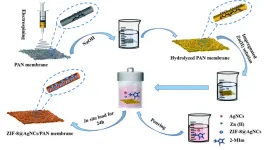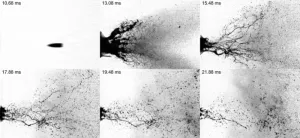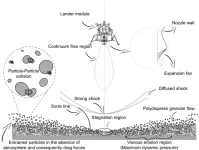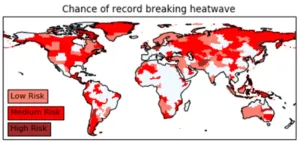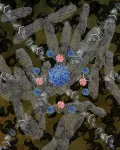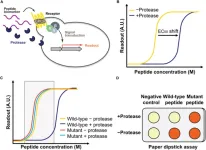(Press-News.org) WASHINGTON, April 25, 2023 – When oil contaminates water, it creates a film that reduces oxygen levels and introduces toxic substances. This can lead to the death of aquatic plants and animals, contaminate soil, and ultimately threaten human health.
Separating oil from polluted water is therefore of great importance. Current methods can be expensive and challenging, and some may introduce further pollutants into the system. For example, membrane materials can act as a barrier to intercept oil, but their efficiency is low and they aren’t suited for long-term use.
In Biointerphases, an AVS journal published by AIP Publishing, researchers in China developed a fabrication method to increase the efficacy and longevity of membrane separation technology. The technology is greater than 99% effective at separating a petroleum ether-in-water emulsion.
The team created a nanofibrous membrane with electrospinning, in which a liquid polymer droplet is electrified and stretched to make fibers. They increased the roughness of the membrane surface by loading it with silver nanoparticles.
In water, this rough surface promotes a stable layer of water, which acts as a barrier to prevent oil droplets from entering the membrane.
“This hydration layer efficiently impedes the passage of oil droplets, reducing membrane pollution and enhancing the composite membrane's permeability and separation efficiency,” said author Jindan Wu.
Silver nanoparticles also enhance the membrane’s antibacterial properties. Incorporating them minimizes the risk of membrane corrosion that can be caused by microorganisms.
“We have discovered that the membrane's surface roughness and hydration layer strength are critical factors that impact its separation performance and anti-fouling ability,” said Wu. “This concept of depositing particles on nanofibrous membranes also has potential for broad applications with other materials.”
The current output capabilities of this fabrication method are relatively low. However, the group hopes developing such materials will contribute to a comprehensive solution for treating water pollution.
“Water pollution is caused by multiple sources, and oily wastewater is just one of them,” said Wu. “It is of vital importance to develop materials that can treat for dyes, heavy metals, and bacteria present in water.”
###
The article “Polyacrylonitrile nanofibrous membrane composited with zeolite imidazole skeleton-8 and silver nanoclusters for efficient antibacterial and emulsion separation” is authored by Huaxiang Chen, Hao Zhou, Mingchao Chen, Yan Quan, Chenglong Wang, Yujie Gao, and Jindan Wu. It will appear in Biointerphases on April 25, 2023 (DOI: 10.1116/6.0002615). After that date, it can be accessed at https://doi.org/10.1116/6.0002615.
ABOUT THE JOURNAL
Biointerphases, an AVS journal published by AIP Publishing, emphasizes quantitative characterization of biomaterials and biological interfaces. As an interdisciplinary journal, a strong foundation of chemistry, physics, biology, engineering, theory, and/or modelling is incorporated into originated articles, reviews, and opinionated essays. See https://avs.scitation.org/journal/bip.
ABOUT AVS
AVS is an interdisciplinary, professional society with some 4,500 members worldwide. Founded in 1953, AVS hosts local and international meetings, publishes five journals, serves members through awards, training and career services programs, and supports networking among academic, industrial, government, and consulting professionals. Its members come from across the fields of chemistry, physics, biology, mathematics, engineering, and business and share a common interest in basic science, technology development and commercialization related to materials, interfaces, and processing.
###
END
Treating polluted water with nanofiber membranes
Adding silver nanoclusters to membranes creates an effective way to separate oily wastewater.
2023-04-25
ELSE PRESS RELEASES FROM THIS DATE:
Trends in buprenorphine initiation and retention
2023-04-25
About The Study: During January 2016 through October 2022, the monthly buprenorphine initiation rate in the U.S. increased, then flattened. This flattening occurred prior to the COVID-19 pandemic, suggesting that factors other than the pandemic were involved.
Authors: Kao-Ping Chua, M.D., Ph.D., of the University of Michigan Medical School in Ann Arbor, is the corresponding author.
To access the embargoed study: Visit our For The Media website at this link https://media.jamanetwork.com/
(doi:10.1001/jama.2023.1207)
Editor’s Note: Please see the article for additional information, including other authors, author contributions ...
Improving bloodstain pattern analysis with fluid dynamics
2023-04-25
WASHINGTON, April 25, 2023 – Often left on the surfaces of a crime scene or on the clothes of an accused criminal, blood back spatter can be used as evidence for forensic scientists to reconstruct what occurred. However, the fluid dynamics at play are complicated, and neglecting the interaction between the blood and the muzzle gases from the firearm could skew the results.
In Physics of Fluids, by AIP Publishing, researchers from the University of Illinois Chicago and Iowa State University modeled the behavior of blood drops during secondary atomization to examine how the phenomenon affects a crime scene.
“Primary atomization of blood is caused by ...
Self-awareness of memory function and clinical progression in cognitively normal older adults
2023-04-25
About The Study: In this study of 436 cognitively normal older adults, unawareness, rather than heightened awareness, of memory decline was strongly associated with future clinical progression, providing further support that discordant self- and informant-reported cognitive decline may provide important information to practitioners.
Authors: Patrizia Vannini, Ph.D., of Brigham and Women’s Hospital in Boston, is the corresponding author.
To access the embargoed study: Visit our For The Media website at this link https://media.jamanetwork.com/
(doi: 10.1001/jamanetworkopen.2023.9964)
Editor’s Note: Please see the article for additional information, including ...
How to land on a planet safely
2023-04-25
WASHINGTON, April 25, 2023 – When a lander descends toward the moon – or a rocky planet, asteroid, or comet – the exhaust plume of the rocket interacts with the surface, causing erosion and kicking up regolith particles. The resulting blanket of dusty debris can create a dangerous brownout effect, limiting visibility and potentially damaging the spacecraft or nearby equipment.
In Physics of Fluids, by AIP Publishing, researchers from Chungnam National University, the University of Edinburgh, Gyeongsang National University, and the Korea Institute of Science and Technology Information ...
Global research reveals countries where record-breaking heatwaves are likely to cause most harm
2023-04-25
A new study has highlighted under-prepared regions across the world most at risk of the devastating effects of scorching temperatures.
The University of Bristol-led research, published today in Nature Communications, shows that unprecedented heat extremes combined with socioeconomic vulnerability puts certain regions, such as Afghanistan, Papua New Guinea, and Central America, most in peril.
Countries yet to experience the most intense heatwaves are often especially susceptible, as adaptation measures are often only introduced after the event. A high chance of record-breaking ...
Using artificial intelligence to create a tsunami early warning system
2023-04-25
Cardiff University media release/Datganiad i’r wasg gan Brifysgol Caerdydd
Under embargo until 16:00 BST/11:00 EST on Tuesday 25 April 2023/O dan embargo tan 16:00 BST/11:00 EST ddydd Mawrth 25 Ebrill 2023
Using artificial intelligence to create a tsunami early warning system
Real-time classification of underwater earthquakes enables earlier and more reliable tsunami alerts
An early warning system that quickly classifies submarine earthquakes and determines the risk of tsunami events has been developed by scientists at Cardiff ...
Researchers at Albert Einstein College of Medicine discover how long-lasting memories form in the brain
2023-04-25
April 25, 2023—(BRONX NY)—Helping your mother make pancakes when you were three…riding your bike without training wheels…your first romantic kiss: How do we retain vivid memories of long-ago events? As described in a paper published online on April 25 in Neuron, researchers at Albert Einstein College of Medicine have found the explanation.
“The ability to learn new information and store it for long periods is one of the brain’s most remarkable features,” said Robert H. Singer, Ph.D., ...
Researchers find rhythmic brain activity helps to maintain temporary memories
2023-04-25
New research shows that rhythmic brain activity is key to temporarily maintaining important information in memory. Researchers at the Del Monte Institute for Neuroscience at the University of Rochester published these findings today in Current Biology that found brain rhythms—or patterns of neuronal activity—organize the bursts of activity in the brain that maintain short-term connections.
“The thought has been that the temporary storage of important information is linked to neurons in the brain that just fire away, retaining that information until it is no longer needed. Recent research has shown that it might not be such persistent ...
Near-universal T cell immunity towards a broad range of bacteria
2023-04-25
Typically T cells of the immune system respond to a specific feature (antigen) of a microbe, thereby generating protective immunity. As reported in the journal Immunity, an international team of scientists have discovered an exception to this rule. Namely, a group of divergent bacterial pathogens, including pneumococci, all share a small highly conserved protein sequence, which is both presented and recognized by human T cells in a conserved population-wide manner.
The study set out to understand immune mechanisms that protect against pneumococcus, a bacterial pathobiont that can reside harmlessly in the upper respiratory mucosae but can also cause infectious ...
Novel living yeast-based dual biosensor for detecting peptide variants
2023-04-25
Biosensors—sensors that can detect biological samples—are powerful tools for understanding the function, composition, and structure of biochemical molecules. Biosensors are often applied for the detection of proteins and their subunits, called peptides, yielding a wide range of biomedical applications. In 2017, researchers from Columbia University in USA engineered a living yeast biosensor by rewiring pheromone-related signaling pathways used by yeast for mating. In the presence of the pheromone peptide, the G-protein coupled receptor (GPCR) could detect the peptide, triggering a cascade that would eventually activate a ...
LAST 30 PRESS RELEASES:
The (metabolic) cost of life
CFRI special issue call for papers: New Frontiers in Sustainable Finance
HKU Engineering scholar demonstrates the smallest all-printed infrared photodetectors to date
Precision empowerment for brain "eavesdropping": CAS team develops triple-electrode integrated functional electrode for simultaneous monitoring of neural signals and chemical transmitters during sleep
Single-capillary endothelial dysfunction resolved by optoacoustic mesoscopy
HKU three research projects named among ‘Top 10 Innovation & Technology News in Hong Kong 2025’ showcasing excellence in research and technology transfer
NLRSeek: A reannotation-based pipeline for mining missing NLR genes in sequenced genomes
A strand and whole genome duplication–aware collinear gene identification tool
Light storage in light cages: A revolutionary approach to on-chip quantum memories
Point spread function decoupling in computational fluorescence microscopy
BacPhase: Long-insert paired-end sequencing for bin marker construction and genome phasing
GmWOX1 regulates the mediolateral polarity of compound leaves in soybean
ChargeFabrica: An open-source simulation tool that aims to accelerate search for high performance perovskite solar cells
High levels of ADAR overexpression induce abundant and stochastic off-target RNA editing in rice protoplasts
On-demand upgraded recycling of polyethylene and construction of sustainable multifunctional materials based on the "LEGO" strategy
New "Stomata in-sight" system allows scientists to watch plants breathe in real-time
Anorexia nervosa may result in long-term skeletal muscle impairment
Narrative-based performance reviews deemed fairest by employees
New insights reveal how advanced oxidation can tackle emerging water pollutants
New review shows how biomass can deliver low-carbon gaseous fuels at scale
Climate change is quietly rewriting the world’s nitrogen cycle, with high stakes for food and the environment
Study finds SGLT-2 inhibitors linked to lower risk of diabetic foot nerve damage
Microbes may hold the key to brain evolution
Study examines how the last two respiratory pandemics rapidly spread through cities
Gender stereotypes reflect the division of labor between women and men across nations
Orthopedics can play critical role in identifying intimate partner violence
Worms as particle sweepers
Second spider-parasitic mite described in Brazil
January 2026 issues of APA journals feature new research on autism, pediatric anxiety, psychedelic therapy, suicide prevention and more
Private equity acquired more than 500 autism centers over the past decade, new study shows
[Press-News.org] Treating polluted water with nanofiber membranesAdding silver nanoclusters to membranes creates an effective way to separate oily wastewater.
